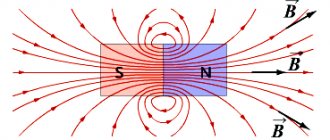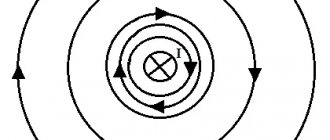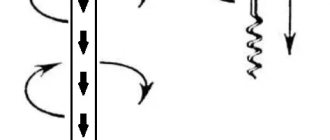Myth 1 – electricity attracts
The myth is popular among the unenlightened population and even some specialists.
It is believed that 220 volts repels, and 380 attracts. This is absolutely false, electricity does not attract.
This whole myth is due to the structure of our muscle fibers. They contract under the influence of electronic impulses that come from our brain.
However, when you somehow touch exposed live wires, your muscles stop listening to you and obey your brain impulses, because they are affected by a stronger current source.
Thus, the muscles begin to contract convulsively and uncontrollably, and in appearance it seems that the person who touched the live wires is attracted by electricity.
You should only check the wire using special instruments; doing this with bare hands is very dangerous.
But if it does, then here’s some advice: do it with the back of your hand, this way you can instantly remove your hand from the wire.
If you touched a live wire with the other side of the ice cream, you would hardly be able to remove your hand without someone else's help.
Myth 2 – the higher the voltage, the greater the chance that you will be electrocuted.
This myth is widespread not only among the unenlightened population, but also among many electricians, engineers and other specialists.
It is believed that the higher the voltage, the greater the chance of dying from electric shock. This is a complete lie.
If a person, standing directly on the ground, touches the phase wire, he will definitely get an electric shock. The principle of grounding works here - electricity tends to the ground.
And the person connected the wire through which it runs to the ground - electricity uses his body as a conductor.
If a person touches the wire while being on an insulator at an advanced height, then there will be no electric shock, because electricity cannot pass through the insulator and the circuit will not close.
Passing through the human body, electricity heats and burns tissue. By interfering with the work of the peripheral nervous system, electricity disrupts the functioning of vital human organs (heart, lungs and others), which, as a rule, is the main cause of death from electric shock.
This heating occurs precisely because of the current.
The same heating occurs in the wiring. Each device connected to the circuit has its own current strength. And the current in the circuit is summed up from all electrical appliances connected to it.
Having too many appliances and creating too much current for the circuit can cause problems.
Impact force
Of decisive importance for the consequences of electric shocks to a person is the time of exposure and the current density (amount per unit area) passing through tissues and organs, as well as the amount of heat generated.
Do not underestimate the likelihood of accidents caused by falls and their associated consequences. Factors influencing the extent of direct damage include :
- type of current (AC or DC);
- frequency (for pulse or alternating);
- the person’s health status and age;
- presence of medical implants in the body;
- the path of flow through the body (for example, arm-arm or left arm-right leg);
- the magnitude of the step voltage.
Injuries from low voltage are more often fatal than from high voltage. The explosive effect of plasma formation when exposed to sources above 1000 V throws the victim away from the conductors, limiting the time of contact.
In such cases, the damage can be surprisingly minor. In contrast, household current at a frequency of 50 Hz can stimulate muscle contraction and cause involuntary seizure, prolonging the effect of electricity, which significantly worsens the consequences.
A similar effect occurs when a person is struck by lightning. This natural phenomenon can be described in the following figures :
- the potential of the electric field between the clouds and the surface of the earth reaches a billion volts;
- the discharge lasts about 0.02 seconds;
- The discharge current can be up to 100,000 A;
- the temperature in the plasma channel can be 10,000 °C.
However, most victims survive exposure to lightning due to its indirect effects, which can be compared to the effects of a blast wave. A direct hit is also rarely fatal due to the short duration of the electric current.
High voltage contacts can sometimes look paradoxical. For example, a bird can sit comfortably on high-voltage power lines. At the same time, the latter can destroy electrical insulators such as paint, leather, ordinary shoes and gloves. This is because the bird, unlike humans, does not have the opportunity to be close enough to the ground to complete the circuit to the ground or expose the insulation of its covers to the destructive effects of the arc.
Myth 3 – bath with hairdryer
Thanks to films, the method of throwing an electric hair dryer into a bathtub of water has become an extremely popular method for suicide and reprisals against husbands and lovers.
But in reality this is unlikely to happen.
In this case, neither one nor the other has been accomplished.
Secondly, water itself is a poor conductor unless it is distilled or saturated with salt ions.
That is, electricity will not pass through water to the human body. The force will cause a short circuit inside the electrical appliance.
And thirdly, every residential building has a circuit breaker that is triggered immediately if there is a short circuit in the circuit or the current strength rises sharply.
I recommend the following video, which explains some myths and facts about electricity:
Physiological effects
Current is the movement of electrons or ions in a conductor. The amount of it flowing through the human body determines the response to electrical shock. Most effects on the body involve heating tissue and stimulating nerves and muscles.
Loss of neuromuscular control can lead to traumatic consequences ranging from falls to respiratory or cardiac arrest. An approximate list of damaging effects is as follows :
- 1 mA - sensitivity threshold, feels like a slight tingling sensation;
- 10-20 mA - the beginning of a stable muscle contraction (it is impossible to let go of the source);
- 50-150 mA - extreme pain, respiratory arrest;
- 100-300 mA - ventricular fibrillation of the heart without lethal outcome with short-term exposure;
- about 2A - cardiac arrest and irreversible damage to internal organs.
Entry points and resistance
The human body has resistance to current. Since it consists almost entirely of water, the lowest conductivity is inherent in its shell - the skin. For a calloused, dry hand, this value can be in excess of a hundred thousand ohms, due to the thick outer layer of keratinized dead cells.
Skin resistance depends on age, sweating, individual characteristics and drops sharply as a result of high-voltage breakdown, cut, deep abrasion or when immersed in water.
Electricity flows from one point to another. A person receiving an electric shock has at least two points of contact with a voltage source, one of which may be ground. Current in a body is capable of passing through several paths simultaneously, in this case its passage is described by Ohm's laws for parallel and series connections.
Approximate Human Resistance:
- hand-to-hand: 1300 Ohm;
- hand-foot: 1000 Ohm;
- arms and legs: 650 Ohm;
- leg-to-leg: 1300 Ohm.
Damage can occur from an electrical arc caused by current passing through air. If it does not contact a person, the consequences will be burns from its heat at the entry point.
High-energy arcs can be accompanied by explosions that create a shock wave that can throw a person, rupture eardrums and damage internal organs.
What in the end...
If we look at the most popular stereotypes about electricity, it turns out that there are many myths about it. For example, that electricity attracts or repels. In fact, electricity affects the muscles more powerfully than the brain impulses, causing them to begin to spasm. From the outside it seems that a person is attracted to electricity.
And the last myth is a bathroom with a hairdryer. It is refuted for three reasons - there is no grounding with the participation of the human body, water itself is a poor conductor, and a circuit breaker is installed in every living room, which is triggered immediately as soon as a short circuit occurs in the circuit or the current strength rises sharply. This way, the victim will not die if he throws a hairdryer or any other electrical appliance into the water.
Write in the comments what other popular myths about electricity do you know that should be refuted?
Source
Causes of defeat
The main cause of electric shock is direct contact with live parts of electrical networks or equipment.
This may happen due to:
- non-compliance with safety regulations at work;
- use of faulty devices;
- contact of electrical equipment with water;
- carelessness in handling electrical equipment;
- unprofessional interference in the operation of electrical installations;
- false reports of power loss;
- actions based on the supposed absence of current on the contacts;
- accidents on live equipment;
- fires and their improper extinguishing.
Many lesions occur due to a phenomenon called stepping potential. The ground potential is 0, that is, in the presence of a phase (an electrode from which current can flow) and a conductor or load between them, a flow of electrons will go to the ground. The described process is reflected in the term grounding. If a person steps and fixes his bare feet on the ground, then the potential difference between them under normal conditions will be 0 V.
This situation changes if a conductor from a high voltage power line comes into contact with the ground. In this case, it closes the circuit transformer - power line - ground - transformer. Since the ground is a poor conductor, the voltage will decrease with increasing distance from the fallen wire. In this case, the potential difference between the feet of a person who has stepped can reach significant values and lead to electric shock along the leg-to-leg path. A similar phenomenon is also observed when a lightning strike strikes the ground.
In addition to lightning, there are other natural sources of electric current that people come into contact with, not without consequences. Electric stingrays, eels and catfish are capable of generating voltages of hundreds of volts at currents of tens and hundreds of milliamps. And although no fatalities have been recorded after an electric shock from these fish, it can stun a person until he loses consciousness.
We create communication
Electricity and electrical phenomena are one of the areas of physics that is still not fully studied and understood, not only for people far from science, but even for specialists with diplomas of all colors and ranks. Therefore, in everyday life or at work you can often hear common myths about electricity, which only confirm what was said above.
Since in everyday life we rarely encounter direct current, and then of extremely weak strength, we will talk specifically about alternating current.
Myth No. 1 - electricity attracts
A popular myth among housewives and even among some certified engineers and manufacturing workers. Allegedly, if you touch exposed wires or faulty live devices, the electric current will certainly attract you and kill you. If there is no particular doubt about the probability of “killing”, then as for “attracting” we can say with confidence that this is just a myth. Electricity does not attract!
This misconception has arisen due to the peculiarity of the functioning of the muscles of the human and animal body, which are controlled by electrical impulses of the nervous system. Under the influence of electricity, the muscles contract, and if, for example, you grab exposed wires with your hands, then it is unlikely that you will be able to open your palms on your own. Your muscles will not obey the electrical impulses of the brain, since they are affected by a stronger source. Such “helplessness” outwardly gives the false impression that electricity has attracted a person.
Of course, you need to check whether the wire is energized only with the help of special instruments, indicators and voltmeters. But, if they are not at hand and, for some unthinkable reason, you still decide to check the wire by touch, then act with the back of your hand, in this case contractions of the arm muscles will not prevent you from instantly moving away from the current source and you will not receive significant damage.
Myth No. 2 - the higher the voltage (number of volts), the more likely it is that you will be killed by an electric shock..
This misconception is more common than the first. And not only among housewives, but even among electrical engineers.
As practice shows, it is the current strength that kills, not the voltage. First, let's look at the standard grounding circuit through the human body, or, as we like to call it, “electric shock.” Here she is, my dear. Please note that this picture is only a schematic illustration of how grounding occurs through the human body.
And so, before us are three lines (three-phase alternating current) and a person demonstrating cases of three probable scenarios for the development of events. One of the main rules to remember is that electricity always looks for the shortest path to go into the ground.
We conclude that the main task for someone who wants to avoid electric shock is under no circumstances to be in the path of electricity to the ground. In all other scenarios, a favorable outcome is not guaranteed.
Here we should add one amendment about voltage. It’s not for nothing that I mentioned the height T (thickness) of the insulator. If the voltage is relatively high, then the thickness of the insulator must be greater to prevent grounding. Because high voltage allows electric current to make “breakdowns” - in other words, to pass through those materials through which it usually cannot do this... through air, an insulator, and so on. For example, at a voltage of 100,000 Volts, 1 cm of transformer oil (insulator and dielectric) breaks through quite freely.
That is, in this regard, voltage is dangerous because the behavior of electricity becomes more dynamic, rubber gloves, which previously served as an excellent insulator at 220 volts, break through. Distance breaks through the air, your rubber sole on your shoes breaks through, and so on.
And now, when even children understand what grounding through the human body is, I think it’s time to start explaining why it’s not the voltage that is to blame for the fatal impact, but the current strength or load in the circuit.
By its nature, the resistivity of the human body is quite high, as a result of which, when an electric current is passed through its tissues, they heat up, burn, and in general their work is disrupted. Also, when an electric current is passed through the human body, the functioning of the peripheral nervous system responsible for breathing, heartbeat and other vital functions of the body is disrupted, which becomes the cause of death.
High current strength can also heat and burn not only organic tissue, but also wiring. And the current strength depends on the power of electrical appliances included in the circuit (network) and is calculated by the formula P = U*I (where P is power (watt), U is voltage (volts), I is current strength (ampere)). For example, if your 3500 watt kettle is connected to a 220 volt circuit, it will cause an increase in current in the circuit of 3500/220 = 15.9 Amperes. This is such a load on the chain. Well, if you also connected all your electrical appliances into one socket (outlet), then the current behind it will be summed up from each electrical appliance. A standard connection diagram in any office and the surprised face of the local residents, asking why the networkers can’t stand it?! Probably Chinese!
By the way, this is the most common cause of fires, especially in those apartments where wiring has not been replaced since Soviet times. But today there are much more electrical appliances, and they are much more powerful. But, as a rule, people solve such problems by replacing the fuse circuit breakers with more powerful ones (with greater amperage), but leaving the wiring just as flimsy. For such owners, a fire is only a matter of time.
Let's summarize - just as the current scorches the wiring, it also burns human tissue. And the probability of death is directly proportional to the current strength in the circuit.
Myth No. 3 - electric bath.
This myth deserves a special plot in the MythBusters program, because it owes its popularity to Hollywood action films as a favorite means of reprisal against unfaithful husbands, lovers... you just need to throw an electric hair dryer into a bathtub filled with water in which your victim is basking, and his death is guaranteed.
Well, firstly, in this myth, circuit A is violated, and the rule “stand in the path of the current”, “along the path of least resistance”. Water itself is a very poor conductor unless it is saturated with salt ions. Since the electricity from a hairdryer or mixer passes partially through the water in which the salts are dissolved, then through the bathtub body and into the ground (floor)... the maximum that will happen is a short circuit (F1-0) inside the hairdryer itself, as an electrical appliance. The likelihood that electricity will pass through the victim's body is extremely low.
Secondly, in any residential premises there is a circuit breaker (EKF), which will operate (cut off the power) in the event of a short circuit and an increase in current in the circuit. The victim won’t even have time to get scared, let alone die.
Source
Factors influencing the nature and severity of electrical injury
Kind and power and voltage
- More than 1000-volt current leads to severe damage, even death, without even touching the source, but being very close - within walking distance from the current source (the so-called “voltaic arc”).
- Alternating current is more dangerous than direct current
- Low frequency current affects internal organs
- High frequency – the surface of the skin, without causing death.
| Current (mA) | The body's reaction when exposed to the hand |
| 0,9-1,2 | Barely perceptible impact |
| 1,2-1,6 | Goosebumps and tickling of the skin |
| 1,6-2,8 | Tension in the wrist |
| 2,8-4,5 | Deterioration of mobility in the forearm |
| 4,5-5,0 | Forearm muscle cramps |
| 5,0-7,0 | Shoulder muscle cramps |
| 15,0-2015,0-20 | The hand does not leave the power source |
| 20-40 | Painful muscle cramps throughout the body |
| 50-100 | Cardiac arrest |
| More than 200 | Deep burns |
The path of current through the body is a current loop
Electrical injury at home
- The most dangerous options are a complete loop, including 2 arms and 2 legs, arm-arm, since the current flows through the heart.
- No less dangerous is the hand-head, when the current passes through the brain.
Tissue resistance and current density
Current density refers to the amount of current passing through a unit area. Energy is concentrated when current passes through a smaller area. For example, if an electric current passes through the hand, the current density increases in the joint area.
Current duration
The longer the current lasts, the stronger the damage and the greater the likelihood of death.
- A high voltage current leads to a sharp contraction of muscles; a person can even be thrown forcefully away from the current source.
- Low voltage current provokes muscle spasm, leading to prolonged involuntary gripping of the conductor by hands. Over time, skin resistance decreases, so it is necessary to interrupt the contact of the victim with the conductor as soon as possible.









